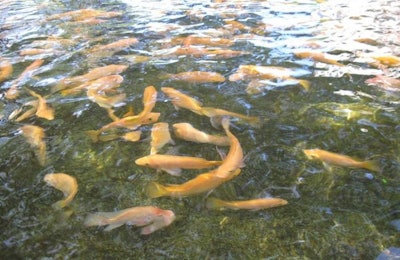
In order to reduce the West African state’s reliance on imported fish, the government of Ghana is aiming to increase aquaculture production next year, starting with the development of a new fish feed production company.
A shortage of quality fish feeds is one of the major issues facing fish farmers in Ghana, according to the fisheries ministry.
Fish feed is the most costly component of aquaculture production, according to Ghana Web. In order to improve the supply situation in the country, Minister of Fisheries and Aquaculture Development Elizabeth Afoley Quaye announced that the ministry has supported the construction of a new aquafeed mill in Akuse. Its capacity of 40,000 metric tons will bring Ghana’s fish feed production to 100,000 metric tons per year, she added.
In collaboration with a private company, the ministry announced it was setting up the aquafeed mill in November 2016, reported Classfm Online. At that time, a further 10,000 metric tons of feed for aquaculture was planned from a fish processing factory in Elmina.
The government’s commitments to the fish farming sector aim to boost national production by 100,000 metric tons in 2018.
Rapid growth in sector
Ghana’s aquaculture output has developed rapidly over recent years. It provided just 2.5 percent of total domestic fish production in 2010, rising to 11.3 percent by 2016, according to figures from the Ministry of Fisheries and Aquaculture Development.
This level of growth has, however, been outpaced by the country’s demand for fish, which is around 990,000 metric tons per year, reports Ghana Web. Ghana has been importing fish to meet this gap in demand at a cost of US$400 million, and Member of Parliament Eric Opoku has called for this amount to be invested in the country’s fisheries sector.
Minister Afoley announced that additional government investment will support an increase of 100,000 metric tons in domestic farmed fish production in 2018 to supplement the fish supply and reduce this trade deficit.
A recent report on Ghana’s fisheries and aquaculture sectors by the United Nations’ Food and Agriculture Organization (FAO) estimated total fish consumption at around 1 million metric tons, while domestic production from marine fisheries, inland waters and aquaculture amounts to 400,000 metric tons, leaving a shortfall of 600,000 metric tons covered by imports.
FAO describes Ghana’s fisheries resources as “heavily overexploited,” and recording a decline in production in recent years. Having started to develop as long ago as the 1950s, Ghana offers great potential for aquaculture in freshwater and brackish water across most regions of the country. The most popular farmed species are Nile tilapia and African catfish.
According to FAO, the first aquaculture feed mill in Ghana was established in 2011, prior to which all feeds were imported and therefore expensive. The country’s major local fish feed company produces about 25,000 metric tons per year for domestic aquaculture farmers, and exports a further 5,000 metric tons to other West African countries.

















